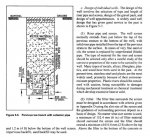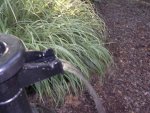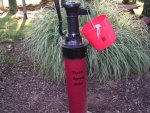Stubb:
On the filtering subject. consider the place where the silt gets stopped before movng farther into the system. If your zone around the pipe is all concrete sand, (I expect the pipe will not be laid right on the bottom in contact with mud) , the silt will stop at that silt- mud contact. The reason I state that is from Corps of Engineer studies in 1938 as well as my work checking subdrains for a Master's degree. The gradation of concrete sand is perfect for all soils carried by water. Adding the sock on the pipe there is not needed.
However, if you have any gravel in the backfill, as you noted in your first post, yes a filter on the pipe is needed, since gravel is not a filter. Experience here in Wisconsin the state guys who approve building code changes, etc. have noted that many of these sock covered foundation drains have failed when the silt builds up on the sock over the slots. Per foot of pipe that is a very small area as compared to the area of sand-mud contact per foot.
I used to specify that fooundation drains have clean-outs so they can be maintained. However, through the years I have found they never have had to be cleaned if the backfill around the pipe is concrete sand. So, I no longer specify clean-outs. In all the past 58 years of my engineering work, that includes many diferent drainage systems, not one has failed, to my knowledge. All had backfill is only concrete sand, no gravel. On the contrary, I have seen many a failed drain system with sock on the pipe and backfill as gravel, some failing the first year.
Getting architects and engineers to use concrete sand instead of gravel is difficult, but I have made considerable progress with various clients. It's very easy when the failure is one year after installation.
On the filtering subject. consider the place where the silt gets stopped before movng farther into the system. If your zone around the pipe is all concrete sand, (I expect the pipe will not be laid right on the bottom in contact with mud) , the silt will stop at that silt- mud contact. The reason I state that is from Corps of Engineer studies in 1938 as well as my work checking subdrains for a Master's degree. The gradation of concrete sand is perfect for all soils carried by water. Adding the sock on the pipe there is not needed.
However, if you have any gravel in the backfill, as you noted in your first post, yes a filter on the pipe is needed, since gravel is not a filter. Experience here in Wisconsin the state guys who approve building code changes, etc. have noted that many of these sock covered foundation drains have failed when the silt builds up on the sock over the slots. Per foot of pipe that is a very small area as compared to the area of sand-mud contact per foot.
I used to specify that fooundation drains have clean-outs so they can be maintained. However, through the years I have found they never have had to be cleaned if the backfill around the pipe is concrete sand. So, I no longer specify clean-outs. In all the past 58 years of my engineering work, that includes many diferent drainage systems, not one has failed, to my knowledge. All had backfill is only concrete sand, no gravel. On the contrary, I have seen many a failed drain system with sock on the pipe and backfill as gravel, some failing the first year.
Getting architects and engineers to use concrete sand instead of gravel is difficult, but I have made considerable progress with various clients. It's very easy when the failure is one year after installation.





